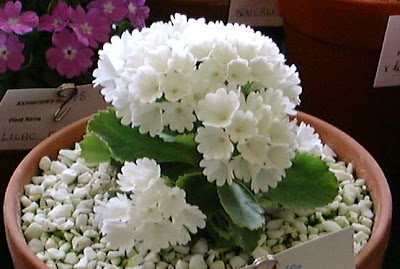 Family Primulaceae
Family PrimulaceaeThere are some 500 species in the genus Primula of which P. obconica, P. sinensis and P. malacoides are the most important for pot culture. Of lesser importance but useful as pot plants are primroses (P. vulgaris), polyanthus (P. vulgaris elarior) and P. kewensis. Primula malacoides was introduced into Great Britain in 1905 by George Forrest. The first introductions were a wishy-washy mauve pink, with small flowers and spindly growth, frail of habit, and with a deplorable tendency to rot at the crown of the plant at the slightest overwatering. However, discerning nurserymen saw the possibilities inherent in the plant, and by a careful selection and breeding programme transformed the original species to a remarkable degree. By 1912 several hybrids possessing white and double flowers were recorded and two years later a very vigorous form with deep pink flowers was introduced. The hybrids available today are obtainable in pure white mauve, various shades of pink and deep red.
Primula obconica was introduced from China in 1880, where it was found in the Ichang gorge in 1879 by Charles Maries. The hybrids which have been raised from the original species are available in white, blue, salmon and crimson shades. Primula sinensis, sometimes called the Chinese primula, was introduced from Canton, China, in 1820, but it was not until 1909 that large-flowered hybrids appeared.
Primula kewensis is not a true species but a hybrid which was produced by chance in the greenhouses of Kew Gardens in 1898. As will be appreciated from the descriptions already given, much breeding of primulas took place during the first half of this century, and many of the hybrids raised were offered as named varieties. Nowadays, as with many other plants, the seedsmen offer packets of mixed colours, but some do still offer named varieties of P. obconica and P. malacoides.